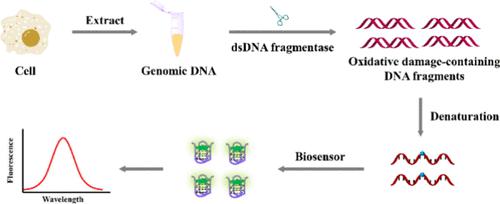当前位置:
X-MOL 学术
›
Anal. Chem.
›
论文详情
Our official English website, www.x-mol.net, welcomes your feedback! (Note: you will need to create a separate account there.)
Elongation and Ligation-Mediated Differential Coding for Label-Free and Locus-Specific Analysis of 8-Oxo-7,8-dihydroguanine in DNA
Analytical Chemistry ( IF 7.4 ) Pub Date : 2024-03-19 , DOI: 10.1021/acs.analchem.4c00387 Ning-ning Zhao 1 , Qian Wang 1 , Dong-ming Yang 2 , Dong-ling Li 3 , Yun Han 3 , Shulin Zhao 2 , Xiaoran Zou 1 , Chun-yang Zhang 3
Analytical Chemistry ( IF 7.4 ) Pub Date : 2024-03-19 , DOI: 10.1021/acs.analchem.4c00387 Ning-ning Zhao 1 , Qian Wang 1 , Dong-ming Yang 2 , Dong-ling Li 3 , Yun Han 3 , Shulin Zhao 2 , Xiaoran Zou 1 , Chun-yang Zhang 3
Affiliation

|
Oxidative DNA damage is closely associated with the occurrence of numerous human diseases and cancers. 8-Oxo-7,8-dihydroguanine (8-oxoG) is the most prevalent form of DNA damage, and it has become not only an oxidative stress biomarker but also a new epigenetic-like biomarker. However, few approaches are available for the locus-specific detection of 8-oxoG because of the low abundance of 8-oxoG damage in DNA and the limited sensitivity of existing assays. Herein, we demonstrate the elongation and ligation-mediated differential coding for label-free and locus-specific analysis of 8-oxoG in DNA. This assay is very simple without the involvement of any specific labeled probes, complicated steps, and large sample consumption. The utilization of Bsu DNA polymerase can specifically initiate a single-base extension reaction to incorporate dATP into the opposite position of 8-oxoG, endowing this assay with excellent selectivity. The introduction of cascade amplification reaction significantly enhances the sensitivity. The proposed method can monitor 8-oxoG with a limit of detection of 8.21 × 10–19 M (0.82 aM), and it can identify as low as 0.001% 8-oxoG damage from a complex mixture with excessive undamaged DNAs. This method can be further applied to measure 8-oxoG levels in the genomic DNA of human cells under diverse oxidative stress, holding prospect potential in the dynamic monitoring of critical 8-oxoG sites, early clinical diagnosis, and gene damage-related biomedical research.
中文翻译:

DNA 中 8-Oxo-7,8-二氢鸟嘌呤的无标记和位点特异性分析的延伸和连接介导的差异编码
DNA氧化损伤与多种人类疾病和癌症的发生密切相关。 8-Oxo-7,8-二氢鸟嘌呤 (8-oxoG) 是最常见的 DNA 损伤形式,它不仅成为氧化应激生物标志物,而且成为一种新的表观遗传样生物标志物。然而,由于 DNA 中 8-oxoG 损伤的丰度较低且现有检测方法的灵敏度有限,因此很少有方法可用于 8-oxoG 的位点特异性检测。在此,我们展示了 DNA 中 8-oxoG 的无标记和位点特异性分析的延伸和连接介导的差异编码。该检测方法非常简单,不需要任何特定的标记探针,步骤复杂,样品消耗量大。利用 Bsu DNA 聚合酶可以特异性启动单碱基延伸反应,将 dATP 掺入 8-oxoG 的相对位置,从而使该测定具有出色的选择性。级联扩增反应的引入显着提高了灵敏度。该方法可以监测 8-oxoG,检测限为 8.21 × 10 –19 M (0.82 aM),并且可以从含有过量未受损 DNA 的复杂混合物中识别出低至 0.001% 的 8-oxoG 损伤。该方法可进一步应用于多种氧化应激下人体细胞基因组DNA中8-oxoG水平的测定,在关键8-oxoG位点的动态监测、早期临床诊断以及基因损伤相关的生物医学研究中具有广阔的前景。
更新日期:2024-03-19
中文翻译:

DNA 中 8-Oxo-7,8-二氢鸟嘌呤的无标记和位点特异性分析的延伸和连接介导的差异编码
DNA氧化损伤与多种人类疾病和癌症的发生密切相关。 8-Oxo-7,8-二氢鸟嘌呤 (8-oxoG) 是最常见的 DNA 损伤形式,它不仅成为氧化应激生物标志物,而且成为一种新的表观遗传样生物标志物。然而,由于 DNA 中 8-oxoG 损伤的丰度较低且现有检测方法的灵敏度有限,因此很少有方法可用于 8-oxoG 的位点特异性检测。在此,我们展示了 DNA 中 8-oxoG 的无标记和位点特异性分析的延伸和连接介导的差异编码。该检测方法非常简单,不需要任何特定的标记探针,步骤复杂,样品消耗量大。利用 Bsu DNA 聚合酶可以特异性启动单碱基延伸反应,将 dATP 掺入 8-oxoG 的相对位置,从而使该测定具有出色的选择性。级联扩增反应的引入显着提高了灵敏度。该方法可以监测 8-oxoG,检测限为 8.21 × 10 –19 M (0.82 aM),并且可以从含有过量未受损 DNA 的复杂混合物中识别出低至 0.001% 的 8-oxoG 损伤。该方法可进一步应用于多种氧化应激下人体细胞基因组DNA中8-oxoG水平的测定,在关键8-oxoG位点的动态监测、早期临床诊断以及基因损伤相关的生物医学研究中具有广阔的前景。



























 京公网安备 11010802027423号
京公网安备 11010802027423号